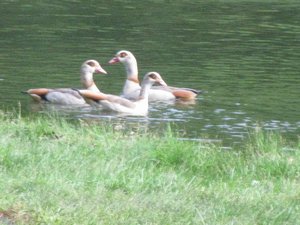Egyptian Geese Return
Saturday 26th June 2010
Two more pictures of Egyptian Geese on the river from last week. These guys stayed for a couple of nights at Ethy Rocks and even popped up to the village one morning for a visit. Thanks to Wendy for the pictures.
Very unusual on the river there has been a lot of interest around these visitors so for those who want to know more..... this is courtesty of Wikipedia
The Egyptian Goose (Alopochen aegyptiacus) is a member of the duck, goose and swan family Anatidae. It is in the shelduck subfamily Tadorninae.
Parent and goslings
This 63–73 cm long species breeds widely in Africa except in deserts and dense forests, and is locally abundant. They are found mostly in the Nile Valley and south of the Sahara. It has also been introduced elsewhere: Great Britain, the Netherlands and Germany have self-sustaining feral populations, the former dating back to the 18th century, though only formally added to the British list in 1971. In Britain, it is found mainly in East Anglia, in parkland with lakes. It was officially declared a pest in the UK in 2009.[1]
This is a largely terrestrial species, which will also perch readily on trees and buildings. It swims well, and in flight looks heavy, more like a goose than a duck, hence the English name.
This species will nest in a large variety of situations, especially in holes in mature trees in parkland. Egyptian Geese usually pair for life. The sexes of this striking species are identical in plumage, though the males average slightly larger. There is a fair amount of variation in plumage tone, with some birds greyer and others browner, but this is not sex or age related. Egyptian geese typically eat seeds, leaves, grasses, and plant stems. Occasionally, they will eat locusts, worms, or other small animals.
Egyptian geese were considered sacred by the ancient Egyptians, and appeared in much of their artwork.
The Egyptian Goose is one of the species to which the Agreement on the Conservation of African-Eurasian Migratory Waterbirds (AEWA) applies.
Its generic name looks like Greek ἀλ�πηξ + χ�ν = "fox-goose", referring to the colour of its back, but with a Greek language error: the linguistically correct form would have been *Alopecchen or *Alopecochen.
